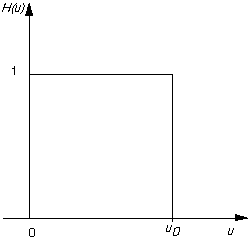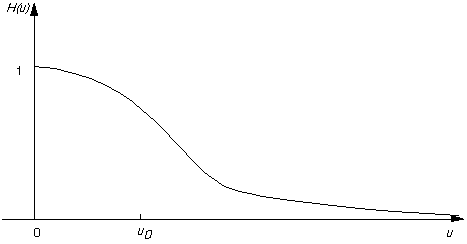where F(u,v) is the Fourier transform of the original image, H(u,v) is a filter function, designed to reduce high frequencies, and G(u,v) is the Fourier transform of the improved image.
Noise in an image means there are many rapid transitions (over a short distance) in intensity from high to low and back again or vice versa, as faulty pixels are encountered.
Therefore noise will contribute heavily to the high frequency components of the image when it is considered in Fourier space.
Thus if we reduce the high frequency components, we should reduce the amount of noise in the image.
We thus create a new version of the image
in Fourier space by computing
![]()
where F(u,v) is the Fourier transform of the original image,
H(u,v) is a filter function, designed to reduce high frequencies, and
G(u,v) is the Fourier transform of the improved image.
Ideal Low Pass Filter
The simplest sort of filter to use is an ideal lowpass filter, which in one dimension appears as shown in Fig. 16.

Fig. 16 Lowpass filter
This is a top hat function which is 1 for u between 0 and ![]() , the
cut-off frequency, and zero elsewhere.
, the
cut-off frequency, and zero elsewhere.
So All frequency space space information above
![]() is thrown away, and all information below
is thrown away, and all information below ![]() is kept.
is kept.
The two dimensional analogue of this is the function
![]()
where ![]() is now the cut-off frequency.
is now the cut-off frequency.
Thus, all frequencies
inside a radius
![]() are kept, and all others discarded.
are kept, and all others discarded.
The problem with this filter is that as well as the noise, edges (places of rapid transition from light to dark) also significantly contribute to the high frequency components.
Thus an ideal lowpass filter will tend to blur edges become blurred.
The lower the cut-off frequency is made, the more pronounced this effect becomes.
Low Pass Butterworth Filter
Another filter sometimes used is the Butterworth lowpass
filter. In this case, H(u,v) takes the form
![]()
where n is called the order of the filter. This keeps some of the
high frequency information, as illustrated by the second order one dimensional
Butterworth filter shown in Fig. 17, and consequently reduces
the blurring.

Fig. 17 A Butterworth filter